Gluek’s Restaurant and Bar
1902, 1979, 1989
PDF of Gluek’s Restaurant and Bar History
Founded in 1857 by Gottlieb Gluek, the Gluek Brewing Company remained within the family until 1964. Gottlieb Gluek was born in Germany in 1828, where he apprenticed to a brewer. He emigrated to the United States in 1855, and subsequently became a foreman at the Orth Brewery in Minneapolis. In 1857, with little capital, he established the Gluek Brewing Company in Minneapolis on 20th Avenue and Marshall Street N.E.

The first year of its operation, the brewery produced 150 barrels. By 1892, it produced 22,000 barrels, five thousand of which were bottled. The brewery focused on a Pilsner and a Lager.
Gottlieb Gluek died in 1880. Gluek had three sons, Louis, Charles, and John. Louis became brew master in 1880, and was called a “Prince of Brewers.” Charles addressed the finances of the brewery (and was a director in the German American Bank). John advanced the brewery’s interests. In 1892, John Gluek reported that the lower alcohol in lager beer “contains sufficient alcohol not to inebriate but to benefit the system.” After the three brothers retired, five of their sons took over responsibility.
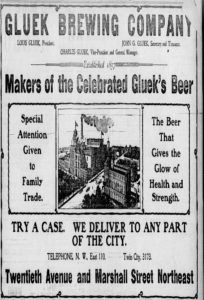
In 1891, a new brewery was built, and in 1902, a Gluek bar opened at 14 Sixth Street North. The bar promoted and sold Gluek beer. The brewery built the bar, put its beer on tap, but then leased the bar to managers.
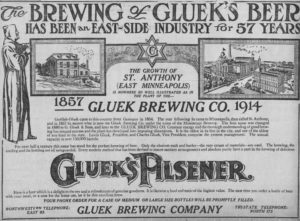
Maintenance of quality was important to the Glueks. Hops were imported from [then named] Czechoslovakia, and premium prices were paid to obtain the best barley.
During Prohibition from 1919 to 1933, Gluek’s kept its plant and organization intact by producing Pilsner Pale in the form allowed by law.
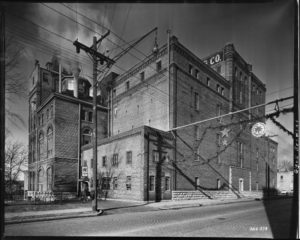
Breweries needed to be creative to survive. Breweries often produced “near beer”—legal brew that contained less than 0.5 percent alcohol. Many brewers survived by selling malt syrup, an extract that could be made into beer by adding water and yeast and allowing time for fermentation.
When election results addressing prohibition came in on November 9, 1933, Gluek’s began setting aside stocks of real Pilsner Pale ready to be sold when the law permitted.
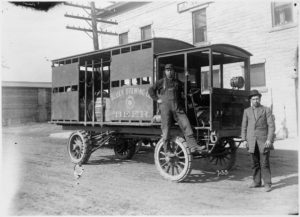
In 1936, Gluek’s introduced cans in its production. Its advertising slogan at that time, “Hear That Bottle Say, Gluek, Gluek, Gluek!” was well-known.
By 1937, Gluek’s was the oldest manufacturing firm in Minneapolis.
By 1939, Gluek’s and Minneapolis Brewing were shipping 1,789 train carloads of beer plus numerous truck loads. Grains used since Prohibition’s repeal in 1933 totaled 25 billion pounds.
Gluek’s Brewery survived four wars, the depressions of the 1890s and 1930s, severe competition, critical shortages, and the prohibition; however, after 107 years in business, in 1964, Gluek’s was sold to G. Heileman Brewing Company. Gluek’s reported that it was not possible for a small brewery to compete with the price cutting of the national breweries.
At one point, Gluek’s had five hundred employees. In 1964, it was down to eighty-five employees and had produced only 90,000 barrels of beer that year. Gluek’s Bar, however, remained.
The 1902 building, designed by Boehme and Cordella, is three-stories and constructed of brick and masonry. The building has decorative terracotta reminiscent of the Beaux-Arts Classical style of architecture. There is a carved “G” on the façade. [In 1903, Boehme and Cordella formed the Boehme & Cordella architectural firm. The partnership lasted eight years. The firm is best known for designing the Swan Turnblad residence, now the American Swedish Institute, in 1903.]
The Gluek building has been owned by the Holcomb family since 1934. It was first leased from Gluek’s and then purchased in 1958. The Bar was originally known as Fransen’s. Charlie Fransen (a Holcomb family ancestor) had emigrated from Germany and worked at the Gluek brewery. Fransen’s operated as a working man’s bar.
In 1979, the building was remodeled, and the name changed from Fransen’s Bar to Gluek’s Restaurant and Bar. The renovation of the interior and exterior restored the building to its original design. The ceilings had graceful, beamed arches, and the bar was decorated with oak paneling, brass, pressed tin, and Tiffany-style billiard lamps.
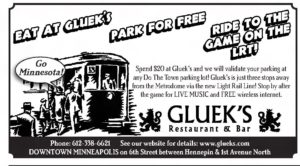
In 1984, the City of Minneapolis designated the exterior of the building an historic property.
In 1989, the building suffered a major fire resulting in the fatality of one of its second-floor residents. Five others were hospitalized. If not for its historic designation, the city’s assistant supervisor of building inspections stated, the building would have been demolished. The owners, however, wanted to save the building.
Nine months and $800,000 later, the Gluek Restaurant and Bar was back in business in February of 1990, along with thirty-four of its thirty-nine employees. In restoring the bar and restaurant, craftspeople relied on photos taken after the 1979 remodeling. The intention was to recreate the distinctive Bavarian beer hall design.
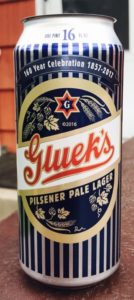
After passing through numerous owners, Cold Spring Brewing purchased the Gluek label and then retired it in 2010.
In 2015, Linda Rae Holcomb obtained the trademark and copyrights for the then 160-year-old beer. She found a German chemist to rewrite the recipe and a Colorado company to produce the beer. In 2017, she reintroduced Gluek beer to the public. Holcomb noted that Gluek’s had been the first to patent malt liquor in the United States, and it was one of only three breweries to supply beer to the U.S. Army in World War II.
Gluek’s continues to operate one hundred and twenty years after it opened. Gluek’s blend of history, culture, and contemporary spirit has made this bar and restaurant a meeting place for generations.
